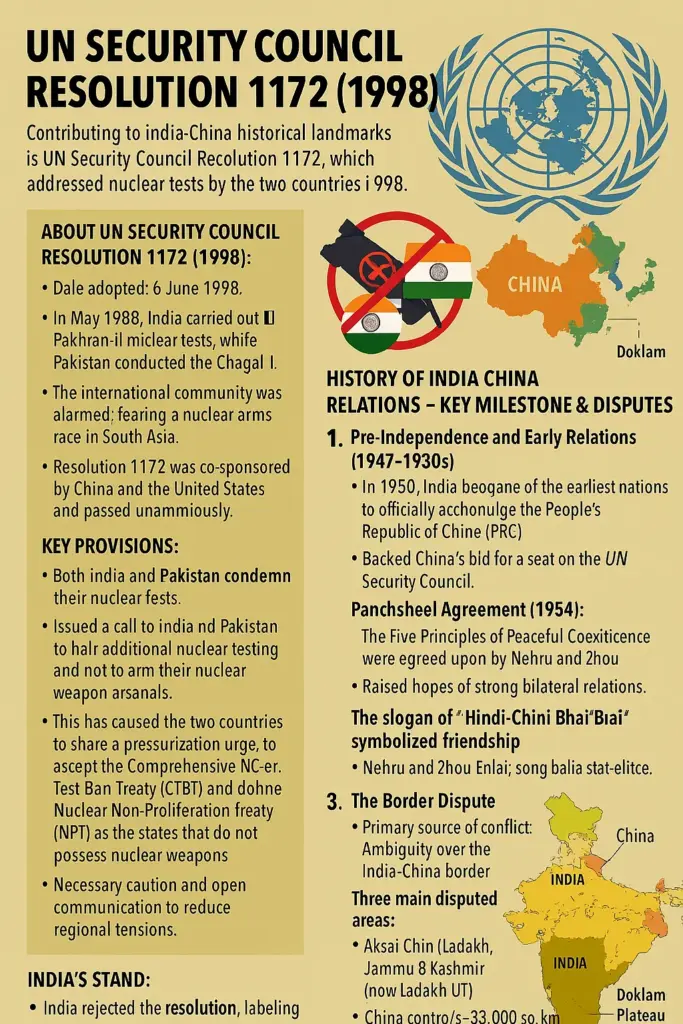September 9, 2025
UNSC Resolution 1172: 5 Key Milestones in India-China Ties
UNSC Resolution 1172 (1998)
The article notes the contribution of the role of former Prime Minister Atal Bihari Vajpayee to the development of the international relations between India and China. He recalls his 1979 trip to China as India’s External Affairs Minister, becoming the first senior Indian leader to visit the country after the 1962 India-China war, and the development of bilateral relationships, the tensions between the countries following India’s championship on nuclear tests in 1998, and the peace-building processes involving dialogue and agreements.
This is within the backdrop of recent India-China tensions along the Line of Actual Control (LAC) and as such, a discussion of historical landmarks, such as UNSC Resolution 1172 and intricate set of controversies between the two countries is pertinent.

About UNSC Resolution 1172 (1998):
- Date adopted: 6 June 1998.
- In May 1998, India carried out the Pokhran-II nuclear tests, while Pakistan conducted the Chagai-I tests.
- The international community was alarmed, fearing a nuclear arms race in South Asia.
- Resolution 1172 was co-sponsored by China and the United States and passed unanimously.
Key Provisions:
- Both India and Pakistan condemn their nuclear tests.
- Issued a call to India and Pakistan to halt additional nuclear testing and not to arm their nuclear weapon arsenals.
- This has caused the two countries to share a pressurization urge to accept the Comprehensive Nuclear-Test-Ban Treaty (CTBT) and don the Nuclear Non-Proliferation Treaty (NPT) as the states that do not possess nuclear weapons.
- Necessary caution and open communication to reduce regional tensions.
- Requested each of the states not to aid India or Pakistan on their nuclear weapons development.
India’s stand:
- India rejected the resolution, labeling it discriminatory, and conducted nuclear tests, citing national security concerns, particularly in light of China’s nuclear capabilities and Pakistan’s close ties with China.
History of India-China Relations – Key Milestones & Disputes
1. Pre-Independence and Early Relations (1947–1950s)
- In 1950, India became one of the earliest nations to officially acknowledge the People’s Republic of China (PRC).
- Backed China’s bid for a seat on the UN Security Council.
- Panchsheel Agreement (1954):
- The Five Principles of Peaceful Coexistence were agreed upon by Nehru and Zhou Enlai.
- Raised hopes of strong bilateral relations.
- The slogan of “Hindi-Chini Bhai-Bhai” symbolized friendship.
2. The Border Dispute
- Primary source of conflict: Ambiguity over the India-China border.
- Three main disputed areas:
- Aksai Chin (Ladakh, Jammu & Kashmir/now Ladakh UT):
- China controls ~38,000 sq. km.
- Strategic importance: Highway connecting Tibet and Xinjiang.
- Arunachal Pradesh (Eastern Sector):
- China claims ~90,000 sq. km. calling it “South Tibet.”
- Doklam Plateau (Bhutan tri-junction area):
- China-Bhutan dispute but strategically vital for India due to its proximity to the Siliguri Corridor (Chicken’s Neck).
- Aksai Chin (Ladakh, Jammu & Kashmir/now Ladakh UT):
3. 1962 India-China War
- Triggered by border clashes and China’s construction of a road through Aksai Chin.
- India was militarily unprepared.
- China announced a one-sided ceasefire while continuing to maintain control of Aksai Chin.
- Major trust deficit created between the two countries.
4. Post-War Relations (1963–1980s)
- Diplomatic freeze for several years.
- 1976: Ambassadors exchanged, marking slow normalization.
- 1979: Atal Bihari Vajpayee, serving as External Affairs Minister, made the first major official visit since 1962.
5. Border Peace-Building (1988–1996)
- 1988 Rajiv Gandhi’s visit to China – turning point for normalization.
- Established a Joint Working Group (JWG) to discuss the border dispute.
- 1993 & 1996 Agreements:
- Confidence-building measures on the LAC.
- Troops to maintain status quo and avoid escalation.
6. Nuclear Tests and 1998 Tensions
- India’s Pokhran-II tests (May 1998):
- PM Vajpayee wrote to U.S. President Bill Clinton, citing China as a threat.
- China strongly opposed and co-sponsored UNSC Resolution 1172 to penalize India.
- 1999: Resumption of dialogue with another JWG meeting despite tensions.
7. 2000s: Economic Engagement and Border Talks
- 2003: PM Vajpayee’s visit to China –
- Recognized Tibet Autonomous Region as part of China.
- China acknowledged Sikkim as part of India later in 2005.
- Initiated talks for a Comprehensive Border Settlement.
- 2005 Agreement on Political Parameters and Guiding Principles for the settlement of the boundary dispute.
8. Recent Flashpoints:
- Doklam Standoff (2017):
- 73-day face-off between Indian and Chinese troops near the tri-junction area of India-Bhutan-China.
- Galwan Valley Clash (2020):
- Deadly confrontation leading to loss of 20 Indian soldiers.
- India banned Chinese apps and restricted Chinese investments post-incident.
- Current Status:
- Along the LAC, no fewer than three sets of talk-level-level Corps Commander-level talks have averted tension.
- Some areas were disengaged but Depsang Plains and Demchok have not been solved.
September 24, 2025
September 23, 2025
September 22, 2025
September 17, 2025
